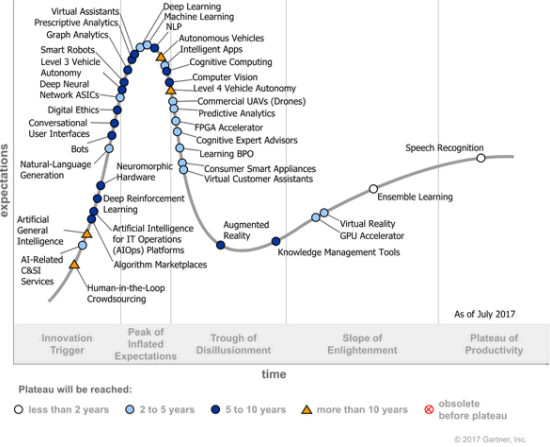By Restb.ai on 15 March 2018
The public has gained most of its information about Artificial Intelligence (A.I.) from Hollywood movies. Audiences' first brush with A.I. near-death experiences came in 2001; that is, 2001: A Space Odyssey. The A.I. in that 1968 Stanley Kubrick film realized it had screwed up its job and tried to jettison the remaining astronaut on the mission. Less famous films like Forbin: The Colossus Project (1970) saw a global A.I. plan to blow up humanity, the source of the world's problems. Of course, in Terminator (1984), A.I. saw humanity as a threat to A.I. existence. The reality of A.I. is less dramatic than all that, of course. In fact, A.I. is already here.
A.I. in Daily Life
While the term “artificial intelligence” dates back to 1956, it has taken many decades to become applicable in our daily lives. Stanford researcher John McCarthy coined the term and defined the key mission of A.I as a sub-field of computer science. It's become big business since then. The A.I market for products and services will grow from USD 419.7 million in 2014 to USD 5.05 billion by 2020, at a CAGR of 53.65% during that period.
It’s in the anti-lock brakes on our car systems, drives our Google online searches, alerts our spam filters, powers driverless cars, recommends books to us on Amazon, opens us to new acts on Spotify, and powers Amazon Alexa's spooky laugh.
A.I. has also come into our daily lives through a technology that delivers sight to the blind through computer vision, as Facebook’s does with its images. It is also in translation software like Google Translate, while IBM's A.I. Watson has won a championship on the American quiz show Jeopardy.

The most recent and astonishing applications have come from the team developing DeepMind, an A.I company that Google acquired in 2014". The British group has taught its entity, which it named AlphaGo, to beat the world's greatest masters of Go, a game that has far more variables than chess. Afterwards, Deep Mind built AlphaGo Zero, which took three days to teach itself how to play Go. It then beat "classic" AlphaGo 100 games to 0.
Today's A.I. Is Kind of Dumb
The process by which AlphaGo and Restb.ai became experts in their fields is called machine learning. Machine learning requires A.I. systems to index and cross-reference their "experience" with incredible amounts of data to become "intelligent." AlphaGo needed a human to teach it the moves of 100,000 games of Go for it to beat professional players. It's with the advent of faster computer microchips, network architectures, and big data that this approach to teaching A.I. has become possible.
Training these deep learning networks can take a very long time though. For instance, teaching a generic computer vision software how to recognize real estate-related fixtures can take months, if not years. Meanwhile, Restb.ai's team has already done all the hard work of training it's plug-n-play A.I. about the features in property images that matter to customers.

The Different Kinds of A.I.
One of the ways to think of the development of A.I. is in three stages: Artificial Narrow Intelligence (ANI), Artificial General Intelligence (AGI), and Super-Intelligent (or Sentient).
All A.I. today is narrow. Researchers use what is called machine learning to teach A.I. how to perform specific tasks. Developers feed an A.I. computer system large amounts of data, which it then uses to learn how to carry out the activity for which it has been updated.
Restb.ai's technology is narrow, or ANI. The Restb.ai team's product excels at a single specialized task: recognizing and categorizing the real estate-specific features of millions of property photos. AlphaGo's narrow A.I.s does incredibly well at playing the game of Go. However, push the board aside and place a chess board "in front" of the computer and it would not know where to begin.
Artificial General Intelligence (AGI) doesn't exist yet. It is supposed to be able to adapt its responses to its environment from one context to another. AGI will be resourceful, learning on its own, from its environment, what it needs to perform activities. AGI can mimic human thought and response. Something as simple as having a robot move from walking across a floor to climbing stairs requires AGI. Narrow A.I. would not be able to adapt quickly enough to make the change in contexts for locomotion.
Super-intelligent A.I. agents, like HAL, in 2001: A Space Odyssey, are a long way off in the future. A.I. sentience elicits all sorts of discussions about how humans and A.I. will solve seemingly intractable problems. One of the most pressing concerns that AGI will assist scientists with is climate change. Predicting highly-changeable weather patterns and human migration paths will prove key to making informed government policy decisions.

On the Horizon: Smart Cities
Managing smart cities is a major challenge to administrators. Myriad sensors planted throughout urban centers will transmit terabytes of real-time data to “the Cloud”. A.I. will become important in collating, integrating, and analyzing the information streaming in from the sensors. It will become an indispensable aid to city administrators tasked with making informed decisions.
The gradual introduction of self-driving cars that use machine learning to navigate cities is ushering in one of the first explicit applications of A.I. in cities. Engineers intend driverless cars to be safer and more fuel-efficient than conventional vehicles.
Singapore is the clear global leader in remaking the city-state to support self-driving vehicles. Since 2014 the city has installed thousands of sensors to monitor traffic flows, phase traffic lights, and host smart parking.
As A.I. technology matures, bet on safer roads, safer neighborhoods and safer homes around the world.

.jpg)


comments